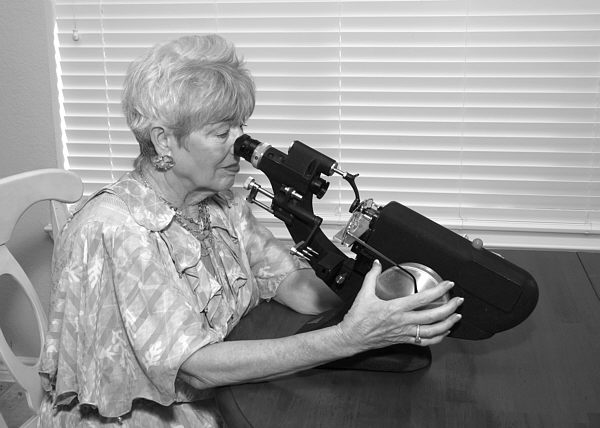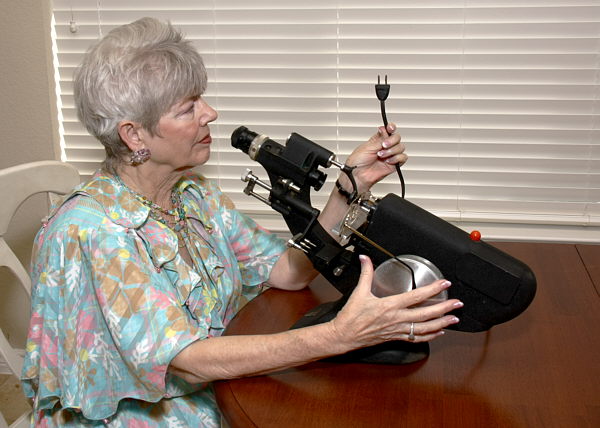Doug Kerr
Well-known member
A few months ago, Carla had eye lens implants in both eyes as a result of advancing cataracts. It was quite successful.
Now that the result has stabilized, she was "refracted" by her ophthalmologist for glasses (mainly for reading, but a full progressive bifocal implementation was specified in the prescription). We had the glasses made at a major store of a well-respected "chain" eyeglass outfit. They made them "in about an hour". A perfunctory check ("look at this National Geographic") suggested that they were OK. But when we got home, it turned out that they were essentially useless.
Carla went back to the ophthalmologist, who "read" the optical properties of the lens (its "prescription") using his focimeter (a vintage American Optical model). The problem was obvious: the "prescription" for the right eye had been applied to the left eye lens, and vice versa.
Back to the eyeglass store. They studiously examined the glasses (I did not see them placed in a focimeter). They reported that no, certainly, the prescriptions for the two sides had not been interchanged. But is seemed as if:
• The segment height was probably not the best. (This refers to the location of the line separating the near vision segment from the rest of the lens in bifocals. These were "progressive add" bifocals, where there is no distinct line, and thus no segment height as such. Nevertheless, there is a comparable concept, so I guess we know what she meant.)
• The lens openings in the frame chosen (this was of course done in consultation with the "customer consultant") were perhaps not high enough to really accommodate the prescription involved. (I had raised the question at the time, and was assured that there would be no problem. What would I know - I'm only a telephone engineer.)
In any case, they gladly remade the glasses - again in "about an hour". The new ones have worked fine.
But it's almost enough to may one want one's own focimeter.
And in fact we got one - on eBay. It is a 1963 vintage Bausch & Lomb "Model 70" Vertometer - considered by some to be the grande dame of the classical manual focimeters.
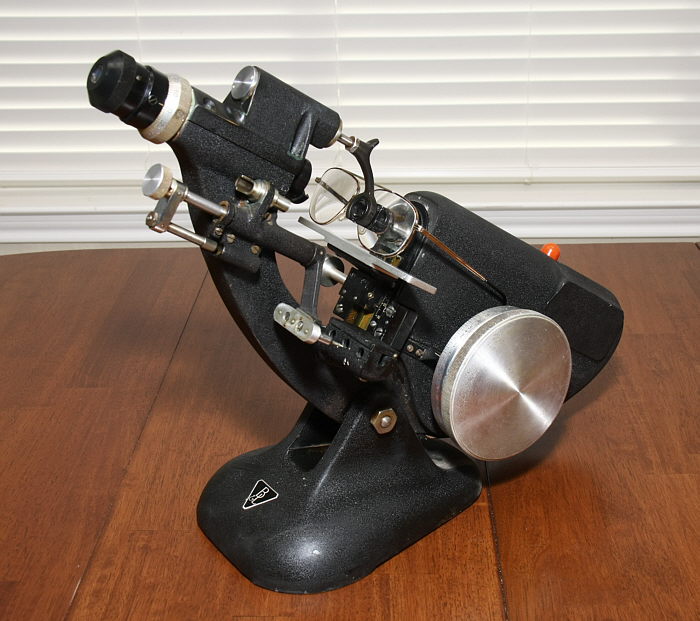
Douglas A. Kerr: Bausch and Lomb "Model 70" Vertometer
from the Carla and Doug Kerr Collection
It was in excellent physical condition, and seemed to work perfectly. (We have no precise way of verifying its state of calibration, but primitive checks suggest it is fine.) It had some rust here and there (it has been in storage for a while), but that was easily taken care of.
We see it with a pair of bifocal eyeglasses on the spectacle table, with the left lens in place for measurement. A four-pronged "chuck" on a spring loaded arm holds the lens against the measuring aperture.
The operation of this instrument, and the significance of its indications, is a complex subject. It will be covered in a technical article I hope to release in just a few days - one of a series of three on optometric matters and instruments.
But here is a short version of the story.
The purpose of the instrument is to measure the refractive power of the eyeglass lens. In the cases of lenses intended to current for astigmatism (as well as for near- or farsightedness), that power is different in different directions, with a maximum and minimum in directions at right angles. (Refractive power is denominated in the unit "diopter".)
This is considered to be the combined effect of a spherical lens (whose power is the same in all directions) and a cylindrical lens (whose power is a maximum in the direction perpendicular to its axis, zero in the direction parallel to its axis, and at intermediate values in between). We describe the lens (in a "prescription") by stating the powers of the spherical and cylindrical components, along with the orientation of the axis of the cylindrical component. (There are two ways to do this, but I won't go into that here.)
The focimeter contains, behind the measuring aperture (and behind another lens), a transilluminated reticle with a pattern comprising three thin, closely spaced parallel lines and three fat, more widely spaced lines at right angles to the thin lines. We see that reticle pattern here:
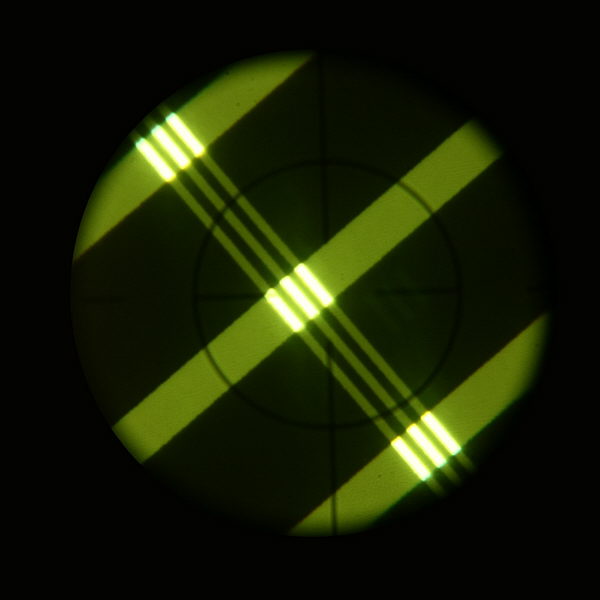
The reticle can be moved along the axis of the instrument by the large wheel we see on the right side (the "power drum"). We move it until the pattern, as seen through the lens being measured, is in best focus, (as we see in the figure above). The drum then indicates the power of the lens implied by this situation.
If the lens contains correction for astigmatism (a "cylinder lens" component), then the lens itself exhibits astigmatism. (Its point is to "cancel out" the astigmatism of the person's eye, by having the opposite kind.)
In such a case, both the sets of lines cannot be simultaneously brought into focus. For example, in this setting of the reticle the thin lines are "in focus", but the fat ones are not.
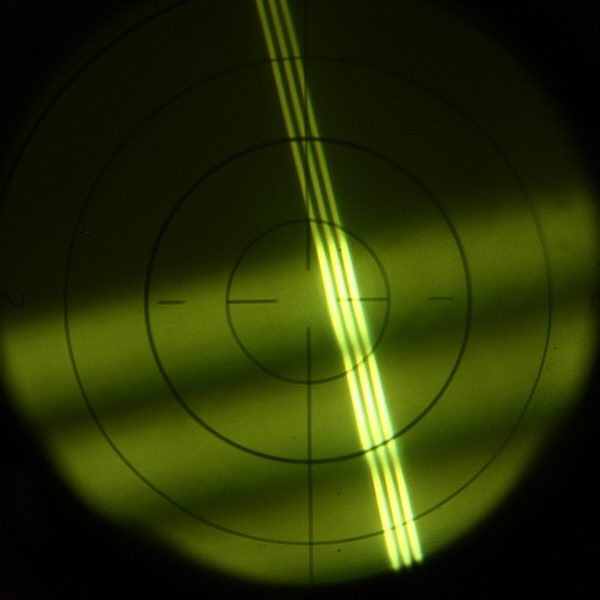
(There is no difference between the two kinds of line, and they are in the same plane on the reticle; they are just running in different directions.) To get this effect, we must have the orientation of the pattern properly match the asymmetry of the lens; a wheel on the left side of the instrument, marked in degrees, rotates it to that end. So we have jiggered both the power drum and the axis wheel to get what we see above.
If we move the reticle some with the power drum (leaving the orientation of the reticle alone), we see this instead; the fat lines are now "in focus" and the thin ones are not:
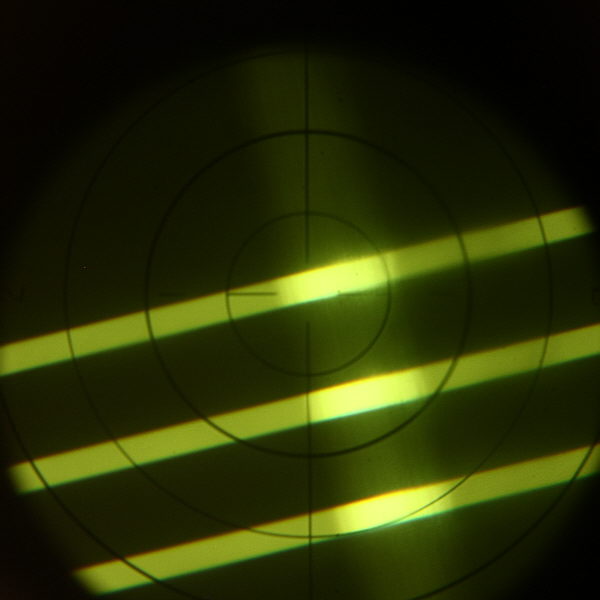
Now, from the readings on the power drum in these two different situations, we can discern both the "spherical" and "cylindrical" power components of the lens' "prescription", the cylinder axis direction being read from the wheel controlling the orientation of the reticle.
Neat, wot?
Best regards,
Doug
Now that the result has stabilized, she was "refracted" by her ophthalmologist for glasses (mainly for reading, but a full progressive bifocal implementation was specified in the prescription). We had the glasses made at a major store of a well-respected "chain" eyeglass outfit. They made them "in about an hour". A perfunctory check ("look at this National Geographic") suggested that they were OK. But when we got home, it turned out that they were essentially useless.
Carla went back to the ophthalmologist, who "read" the optical properties of the lens (its "prescription") using his focimeter (a vintage American Optical model). The problem was obvious: the "prescription" for the right eye had been applied to the left eye lens, and vice versa.
Back to the eyeglass store. They studiously examined the glasses (I did not see them placed in a focimeter). They reported that no, certainly, the prescriptions for the two sides had not been interchanged. But is seemed as if:
• The segment height was probably not the best. (This refers to the location of the line separating the near vision segment from the rest of the lens in bifocals. These were "progressive add" bifocals, where there is no distinct line, and thus no segment height as such. Nevertheless, there is a comparable concept, so I guess we know what she meant.)
• The lens openings in the frame chosen (this was of course done in consultation with the "customer consultant") were perhaps not high enough to really accommodate the prescription involved. (I had raised the question at the time, and was assured that there would be no problem. What would I know - I'm only a telephone engineer.)
In any case, they gladly remade the glasses - again in "about an hour". The new ones have worked fine.
But it's almost enough to may one want one's own focimeter.
And in fact we got one - on eBay. It is a 1963 vintage Bausch & Lomb "Model 70" Vertometer - considered by some to be the grande dame of the classical manual focimeters.

Douglas A. Kerr: Bausch and Lomb "Model 70" Vertometer
from the Carla and Doug Kerr Collection
It was in excellent physical condition, and seemed to work perfectly. (We have no precise way of verifying its state of calibration, but primitive checks suggest it is fine.) It had some rust here and there (it has been in storage for a while), but that was easily taken care of.
We see it with a pair of bifocal eyeglasses on the spectacle table, with the left lens in place for measurement. A four-pronged "chuck" on a spring loaded arm holds the lens against the measuring aperture.
The operation of this instrument, and the significance of its indications, is a complex subject. It will be covered in a technical article I hope to release in just a few days - one of a series of three on optometric matters and instruments.
But here is a short version of the story.
The purpose of the instrument is to measure the refractive power of the eyeglass lens. In the cases of lenses intended to current for astigmatism (as well as for near- or farsightedness), that power is different in different directions, with a maximum and minimum in directions at right angles. (Refractive power is denominated in the unit "diopter".)
This is considered to be the combined effect of a spherical lens (whose power is the same in all directions) and a cylindrical lens (whose power is a maximum in the direction perpendicular to its axis, zero in the direction parallel to its axis, and at intermediate values in between). We describe the lens (in a "prescription") by stating the powers of the spherical and cylindrical components, along with the orientation of the axis of the cylindrical component. (There are two ways to do this, but I won't go into that here.)
The focimeter contains, behind the measuring aperture (and behind another lens), a transilluminated reticle with a pattern comprising three thin, closely spaced parallel lines and three fat, more widely spaced lines at right angles to the thin lines. We see that reticle pattern here:

The reticle can be moved along the axis of the instrument by the large wheel we see on the right side (the "power drum"). We move it until the pattern, as seen through the lens being measured, is in best focus, (as we see in the figure above). The drum then indicates the power of the lens implied by this situation.
If the lens contains correction for astigmatism (a "cylinder lens" component), then the lens itself exhibits astigmatism. (Its point is to "cancel out" the astigmatism of the person's eye, by having the opposite kind.)
In such a case, both the sets of lines cannot be simultaneously brought into focus. For example, in this setting of the reticle the thin lines are "in focus", but the fat ones are not.

(There is no difference between the two kinds of line, and they are in the same plane on the reticle; they are just running in different directions.) To get this effect, we must have the orientation of the pattern properly match the asymmetry of the lens; a wheel on the left side of the instrument, marked in degrees, rotates it to that end. So we have jiggered both the power drum and the axis wheel to get what we see above.
Incidentally, in this and the following figures, the pattern is not centered on the eyepiece reticle (the black polar pattern). That's because I neglected to adjust the position of the lens under test to place its optical center on the instrument axis, as would normally be done at the beginning of the test.
If we move the reticle some with the power drum (leaving the orientation of the reticle alone), we see this instead; the fat lines are now "in focus" and the thin ones are not:

Now, from the readings on the power drum in these two different situations, we can discern both the "spherical" and "cylindrical" power components of the lens' "prescription", the cylinder axis direction being read from the wheel controlling the orientation of the reticle.
Neat, wot?
Best regards,
Doug


